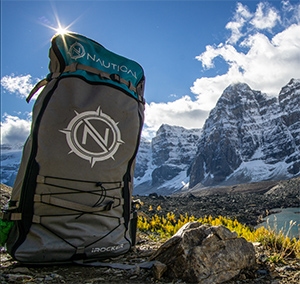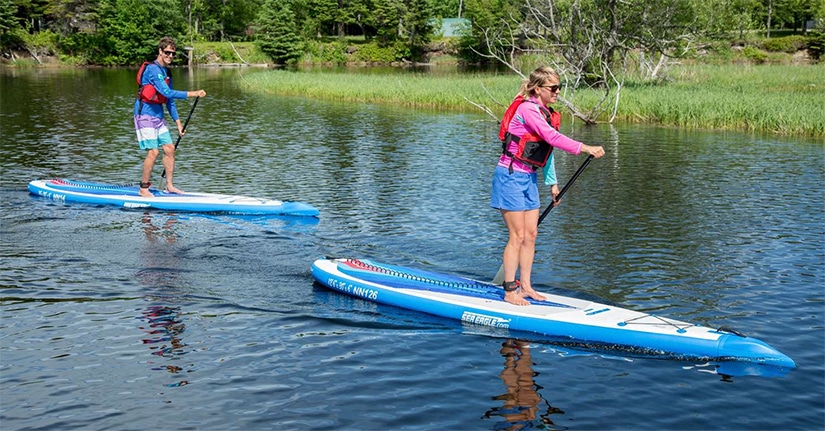Which is better: an inflatable or a rigid paddle board? This is one of the major decisions you have to make when buying a SUP.
Now, it would be nice to have a straightforward answer, but it wouldn’t be truthful. The answer depends on your lifestyle and how you want to use the paddle board.
Both stand up paddle board types are amazing and have their benefits. They also have downsides.
So how do you decide?
We are going to have an honest inflatable paddle board vs hard SUP discussion. Hopefully, knowing who and what each type is best for will help you make the right decision.
RELATED: Discover the best inflatable paddle boards for beginners
Key Takeaways
- The main difference between inflatable paddle board vs hard SUP boards is the construction and board design.
- Hard standup paddle boards offer superior performance. They are exceptionally rigid, faster, and more agile.
- But one of the main advantages of having an iSUP is portability. Most paddlers are adventurous and love traveling with their paddle boards, so having a board that packs down into a bag is a fantastic bonus!
- Inflatable SUPs are also cheaper than traditional hard boards and are more durable too
The Difference Between Inflatable and Solid Paddle Boards
The main difference between inflatable paddle board vs hard SUP boards is the construction and board design.
Let’s take a closer look.
What Are Inflatable SUP Boards?
An inflatable paddle board is a board that can be inflated and deflated, as you can guess from the name. It is also known as an iSUP.
Inflatable SUP boards are built using drop stitch and PVC material.
With drop stitch construction, two layers of fabric are joined together using thousands of tiny threads. This ensures that the inflatable stand up paddle board maintains its shape when inflated.
But the drop stitch layers are not airtight, and that’s where PVC comes in. A layer of PVC is added to make the paddle board airtight.
Some iSUPs have one PVC layer while others have multiple layers. More layers translates to a more rigid inflatable board. But it can also mean having to deal with a heavier SUP.
Paddle boards made with a single layer are lighter but their rigidity can be disappointing. Some of them flex, especially with a heavier rider on board.
Different manufacturers use different techniques to make stiff but light inflatables.
What Are Rigid SUP Boards?
Rigid or ‘traditional’ stand up paddle boards are not inflatable. They are also known as fiberglass or epoxy boards.
The construction of rigid SUP boards starts with a foam core. From there you have layers of fiberglass, bamboo, wood veneer, plastic, or other materials.
One of the best things about hardboards is that you don’t have to worry about flex.
You may also notice that solid paddle boards are thinner and tapered, unlike iSUPs. Their thickness is not uniform all along the length of the board.
Inflatable Paddle Boards Vs Hard SUPs: An Honest Comparison
Now that you know what makes iSUPs and hard boards different, let’s see how they compare.
1. Paddle Board Performance
Hard standup paddle boards offer superior performance. They are exceptionally rigid, faster, and more agile.
This is not to say that inflatable boards don’t perform. But epoxy boards glide so well with less drag.
With better speed and maneuverability, hardboards are the best option for serious SUP surfing and racing.
However, the construction of inflatable paddle boards has come a long way. Their performance has improved. As a result, the difference in speed between these two paddle board types isn’t that big.
There are some well-made inflatable SUPs that will impress you with their performance.
2. Durability
The construction of both fiberglass boards and inflatable SUPs is an important differentiating factor.
The material used to make inflatable stand up paddle boards is military-grade. They are unbelievably durable.
But inflatable paddle boards are pretty durable too. It is easy to think that iSUPs are just like any other inflatable water toy,but you’d be surprised by how much they can handle.
While solid boards can easily get dented when you bump into rocks, inflatables will just bounce off. This makes them perfect for white water paddling.
You can throw your inflatable board off a roof, run it over with your car, or accidentally drop it on concrete and it will be fine. You cannot say the same about a traditional SUP board.
If you’re doubting, check the inflatable durability tests on YouTube. Red Paddle Co has the craziest tests; you’ll be amazed.
Also read our Atoll paddle board review – one of the most durable SUPs on the market.
3. Portability
One of the main advantages of having an iSUP is portability. Most paddlers are adventurous and love traveling with their paddle boards.
An inflatable SUP allows you to explore different bodies of waters, near and far.
Once you are done using your inflatable paddle board, deflate and roll it up to the size of a sleeping bag. You don’t need a truck or a car roof rack to transport it.
You can even fly with it all over the country for vacations. You won’t have to rent a paddle board everywhere you go.
This can’t be said about solid SUP boards. Can you imagine transporting a 12-foot long board by plane? You would pay ridiculous fees and some airlines won’t even allow a long SUP. Even thinking about it is stressful!
iSUPs are also the best for hiking. They come with a backpack that can accommodate the board and the rest of your SUP accessories.
4. Storage
How will you store your paddle board? This is one of the many questions you have to ask before buying a SUP. If you want your board to last, you have to store it properly.
Unless you are storing it inflated, a blow-up stand up paddle board doesn’t need much storage space. It will fit under the bed, in your closet, or somewhere in a corner. It is perfect for paddle boarders who live in small apartments or people who generally don’t have much space.
Hard boards can be tricky because they don’t deflate and require more space.
So the winner in this category is inflatable paddle boards (for a paddler with limited storage space).
Inflatable SUP Benefits
Why should a beginner choose an inflatable SUP over a fiberglass one?
The main reason is probably portability and storage. If you travel a lot and like to bring your SUP with you, an inflatable is a great option. Checking in at the airport will be a breeze and so will be hiking with your paddle board.
Rolled up inflatables are compact and you can store them anywhere.
The other benefit is that inflatable stand up paddle boards have better stability and a higher rider weight capacity. They are thicker and have more volume, which allows them to support more weight. Some single-rider iSUPs, like the Atoll 11’, can hold as much as 700 lbs–which is remarkable.
Inflatable boards have a softer surface. Why does this matter? Because you will most likely fall while paddle boarding. When that happens and you hit the SUP, you will be glad you got a blow-up board. The surface is more forgiving compared to a hard board’s surface.
Generally, inflatable SUP boards are cheaper. You can get a full iSUP package for as low as $300. The package includes a paddle board, paddle, leash, backpack, and a manual pump. That’s all you need to get started with the sport!
Inflatables are more durable than traditional boards. The military-grade material used to make them is no joke. You won’t have to panic every time you bump into something while paddling.
The iSUP will just bounce off the object. Hardboards can easily get dings and dents. That is why they are not a good option for white water paddleboarding.
Lastly, inflatable SUPs are lighter. Epoxy boards can be heavy and a pain to carry across the beach, especially if you are on the smaller side.
Hard SUP Benefits
Many paddlers choose hardboards because of their performance. They are fast, responsive, and glide so smoothly on the water. These boards are great for catching waves and racing.
You can surf and race with inflatable SUP boards, but they can only handle smaller waves and you certainly won’t be winning any SUP races if the other participants have traditional racing boards.
Another benefit of hard SUPs is that they don’t require inflation and deflation. This may be a downside for storage and transport but it has its advantages. Having to inflate and deflate your paddle board every time isn’t fun.
Using an electric pump takes less effort but you still have to wait a few minutes for it to inflate.
With a fiberglass SUP, you can take it from your car and straight to the water. Once you are done paddling, load it onto the car and get moving. No setup is required.
Inflatable Paddle Board Vs Rigid Paddle Board: Which One Is Right for You?
An inflatable SUP board is suitable for the rider with limited storage space. It is also for you if you’d like to travel with your paddle board.
You should consider an iSUP if you want to paddle an area with a lot of rocks and obstacles. It will not get easily damaged.
An inflatable may also be for you if you are looking for quality on a budget. You will have many options. You can get a good entry-level board from a reputable brand like iRocker or Bluefin SUP Boards.
A rigid paddle board would be great for serious SUP surfing, racing, and long-distance touring.
You should also go for an epoxy board if you don’t like the idea of inflating and deflating your board every time.
Inflatable Vs Solid FAQs
What are the main differences between inflatable and hard paddle boards?
The main differences between inflatable and hard paddle boards lie in their construction, performance, and convenience. Inflatable paddle boards are more portable than hard boards, making them ideal for travelers and those with limited storage space. They are also softer, which can be more comfortable for beginners and yoga enthusiasts. On the other hand, hard paddle boards, or rigid boards, offer better performance for serious surfers due to their increased rigidity. Hard sups are more stable because they have a larger surface area on the water, making them less tippy and better for speed and agility in a sup race. Finally, inflatable paddle boards are inherently more convenient due to their less demanding maintenance and storage requirements.
Which type of paddle board is better for beginners?
For beginners, an inflatable paddle board is generally better than a hard paddle board. Inflatable paddle boards are inherently more convenient due to their less demanding storage and transportation requirements. They are also more forgiving if you fall, as they are softer than solid boards. In contrast, hard paddle boards, though more stable because they have a larger surface area on the water, are heavier and can be more difficult to handle for novices. Additionally, inflatable SUPs are more portable than hard boards, making them ideal for those new to the sport of stand-up paddleboarding. Finally, beginners will appreciate that the inflatable version is much easier for them to use, providing ample opportunities to learn and improve their skills.
How does the performance of inflatable paddle boards compare to hard boards?
The performance of inflatable paddle boards vs hard paddle boards varies based on several factors. Inflatable paddle boards are inherently more convenient due to their portability and storage ease, making them ideal for travel. However, hard paddle boards generally offer better performance in terms of speed and agility, which is why serious surfers often prefer them. Hard sups are more stable because they have a larger surface area on the water, making them less tippy and better for rough conditions. Ultimately, the choice between inflatable and hard boards depends on your specific paddling needs and preferences.
Are inflatable paddle boards as durable as hard boards?
Inflatable paddle boards are generally durable but have some differences compared to hard boards. While inflatable paddle boards are inherently more convenient due to their less demanding storage and transport needs, they are more prone to punctures. Hard paddle boards, on the other hand, offer better rigidity and stability, making them less tippy and heavier. Serious surfers often prefer hard boards due to their increased rigidity, providing better performance in challenging conditions. Inflatable SUPs are softer than solid boards, but advancements in technology have made them highly resilient and capable of handling various paddling environments.
Overall, the choice between inflatable and hard paddle boards depends on your specific needs, such as portability, ease of use, and the type of paddle boarding you plan to do.
Which is easier to transport: inflatable or hard paddle boards?
Inflatable paddle boards are inherently more convenient due to their less demanding nature when it comes to transportation. These boards are more portable than hard boards because they can be deflated and packed into a compact bag, making them easy to carry and store. On the other hand, hard paddle boards are heavier and rigid, making them difficult to transport, especially for those without a large vehicle. For those who value portability and ease of transport, inflatable sup boards are a better choice than hard paddle boards.
What are the cost differences between inflatable and hard paddle boards?
The cost differences between inflatable paddle boards and hard paddle boards can be significant. Inflatable paddle boards are generally more affordable, making them a popular choice for beginners and casual paddlers. They are inherently more convenient due to their less demanding storage and transport requirements. On the other hand, hard paddle boards are typically more expensive but offer better performance and durability, especially for serious surfers and advanced paddlers. Hard sups are more stable because they have a larger surface area on the water, making them less tippy and heavier. The inflatable version is much easier for beginners to use and is more portable than hard boards. Ultimately, the choice depends on your paddling needs and budget.
In conclusion, while inflatable paddle boards provide a cost-effective and portable option, hard paddle boards offer enhanced stability and performance at a higher price point. It’s worth considering your specific paddle boarding activities to determine which type best suits your needs.
Can inflatable paddle boards be used for surfing?
Yes, inflatable paddle boards can be used for surfing, but they have some differences compared to hard paddle boards. Inflatable paddle boards are more portable and inherently more convenient due to their less demanding storage and transport needs. However, serious surfers might prefer a hard board because of its increased rigidity, which provides better performance in the waves. Hard paddle boards are less tippy, heavier, and better suited for advanced surfing. Inflatable SUPs, on the other hand, are softer and more forgiving, making them easier for beginners to use in various surf conditions.
In conclusion, while inflatable paddle boards offer plenty of opportunities for fun and versatility, hard paddle boards might be better for those seeking high performance and stability in surf scenarios.
How does the weight of inflatable paddle boards compare to hard boards?
When considering the weight of inflatable paddle boards vs. hard paddle boards, there are notable differences. Inflatable paddle boards are generally more portable than hard boards, making them easier to transport and store. Inflatable SUPs are inherently more convenient due to their less demanding storage requirements, allowing them to be deflated and packed into a compact bag. On the other hand, hard paddle boards are typically heavier and more rigid, offering better stability and performance in rough water conditions. Serious surfers are better off using a hardboard due to the increased rigidity, which provides a more responsive stand-up paddle boarding experience. Therefore, the choice between inflatable and hard paddle boards often depends on individual needs and the specific conditions in which they will be used.
Which paddle board is better for yoga and fitness?
When it comes to yoga and fitness, an inflatable paddle board has some advantages over a hard paddle board. Inflatable SUP boards are inherently more convenient due to their portability and ease of storage. They are softer, providing a more comfortable surface for yoga poses. On the other hand, hard paddle boards are less tippy, heavier, and better for stability due to their rigid structure. This stability can be crucial for maintaining balance during more challenging poses.
In conclusion, both types have their merits, but inflatable boards are generally better for yoga and fitness due to their comfort and convenience. Additionally, inflatable SUPs are more portable than hard boards, making them easier to transport to different locations for your yoga sessions. However, if you prioritize stability and a solid platform, you might find a hard paddle board more suitable for your needs. Ultimately, it’s about crafting your unique stand up paddle boarding experience to suit your fitness goals.
Are there any size differences between inflatable and hard paddle boards?
Yes, there are size differences between inflatable and hard paddle boards. Inflatable paddle boards are typically more portable than hard boards because they can be deflated and rolled up, making them easier to store and transport. This flexibility allows inflatable boards to come in a variety of sizes to suit different activities, such as yoga or racing. In contrast, hard boards, or rigid sups, are less tippy and generally offer better stability due to their solid construction. This makes hard sups a preferred choice for serious surfers and those seeking a more rigid board for performance paddling.
Inflatable paddle boards are inherently more convenient due to their less demanding storage requirements. However, hard boards often provide a more authentic paddling experience with their superior rigidity. Ultimately, the choice between inflatable and hard boards depends on your specific needs and the type of stand-up paddleboarding you plan to do.
Wrapping Up
Inflatable SUP vs hard paddle board: which one will you choose?
Each paddle board type comes with its benefits and downsides. So it all comes down to what your priority is.
Inflatable stand up paddleboards are affordable, durable, portable, and easy to store. They have a soft surface that won’t hurt a lot if you fall and hit the board.
Hard boards offer better speed and overall performance. You also don’t have to inflate your hard standup paddleboard every time you go paddling.
If you have any questions feel free to ask us. Happy paddling!





